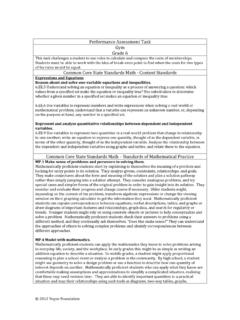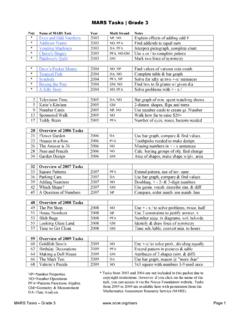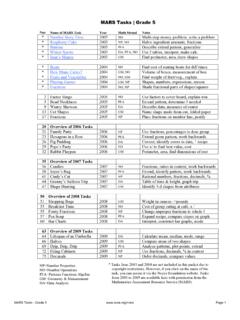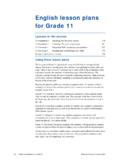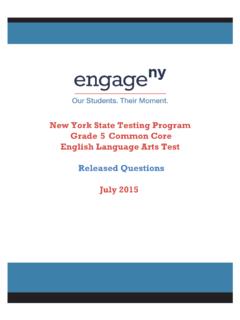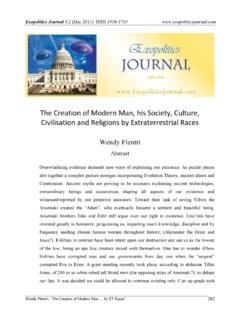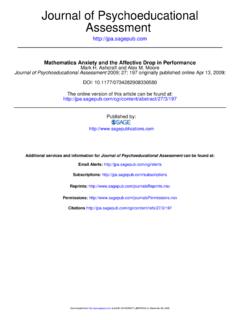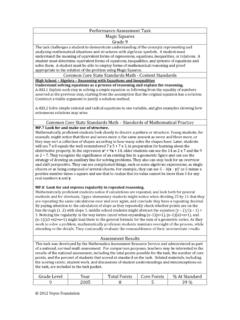Transcription of Performance Assessment Task Decimals Common Core State ...
1 Performance Assessment Task Decimals Grade 5. This task challenges a student to use knowledge of place value system to represent and compare rational numbers. A student must use place value understanding to justify or explain how to order a set of decimal values. A student must be able to make sense of rational values to generate numbers falling between two values. Common Core State Standards Math - Content Standards Number and Operations in Base Ten Understand the place value system. Read, write, and compare Decimals to thousandths. a. Read and write Decimals to thousandths using base-ten numerals, number names, and expanded form, = 3 x 100 + 4 x 10 +7 x 1 + 3 x (1/10) = 9 x (1/100) =+2 x (1/1000). b. Compare two Decimals to thousandths based on meanings of the digits in each place, using >, =, and <. symbols to record the results of comparisons. Use place value understanding to round Decimals to any place value.
2 Common Core State Standards Math Standards of Mathematical Practice Construct viable arguments and critique the reasoning of others. Mathematically proficient students understand and use stated assumptions, definitions, and previously established results in constructing arguments. They make conjectures and build a logical progression of statements to explore the truth of their conjectures. They are able to analyze situations by breaking them into cases, and can recognize and use counterexamples. They justify their conclusions, communicate them to others, and respond to the arguments of others. They reason inductively about data, making plausible arguments that take into account the context from which the data arose. Mathematically proficient students are also able to compare the effectiveness of two plausible arguments, distinguish correct logic or reasoning from that which is flawed, and if there is a flaw in an argument explain what it is.
3 Elementary students can construct arguments using concrete referents such as objects, drawings, diagrams, and actions. Such arguments can make sense and be correct, even through they are not generalized or made formal until later grades. Later, students learn to determine domains to which an argument applies. Students at all grades can listen or read the arguments of others, Attend to precision. Mathematically proficient students try to communicate precisely to others. They try to use clear definitions in discussion with others and in their own reasoning. They State the meaning of symbols they choose, including using the equal sign consistently and appropriately. They are careful about specifying units of measure, and labeling axes to clarify the correspondence with quantities in a problem. They calculate accurately and efficiently, express numerical answers with a degree of precision appropriate for the problem context.
4 In the elementary grades, students give carefully formulated explanations to each other. By the time they reach high school they have learned to examine claims and make explicit use of definitions. Assessment Results This task was developed by the Mathematics Assessment Resource Service and administered as part of a national, normed math Assessment . For comparison purposes, teachers may be interested in the results of the national Assessment , including the total points possible for the task, the number of core points, and the percent of students that scored at standard on the task. Related materials, including the scoring rubric, student work, and discussions of student understandings and misconceptions on the task, are included in the task packet. Grade Level Year Total Points Core Points % At Standard 5 2009 9 4 2012 Noyce Foundation Decimals This problem gives you the chance to: show understanding of decimal numbers 1.
5 Write each of this set of numbers in the correct box. The box on the left is for numbers smaller than The box on the right is for numbers bigger than The first one has been done for you. Numbers smaller than Numbers bigger than 2. Which number is nearest to _____. Explain how you figured this out. _____. _____. 3. Write down a number of your own that is bigger than and smaller than _____. 4. Write the numbers in order from smallest to largest. _____. Explain how you decided which was the smallest number. _____. _____9. Grade Five Decimals Copyright 2009 by Mathematics Assessment 85. Resource Service. All rights reserved. Decimals Rubric The core elements of Performance required by this task are: show understanding of decimal numbers section Based on these, credit for specific aspects of Performance should be assigned as follows points points 1. Gives correct answers: In the left hand box: 3. In the right hand box: ( ), Partial credit (2).
6 Lose one point for each number incorrectly placed (1). 3. 2. Gives correct answer: 1. Gives a correct explanation such as: 2. It rounds to and no other number does. 1. 3. Gives correct answer: any number larger than and less than 1. 1. 4. Gives correct answer: 2. Partial credit One error or First and last correct. (1). Gives a correct explanation such as: I looked at the first number after the decimal point and choose zero because it was smallest. 1. 3. Total Points 9. Grade Five 86. Copyright 2009 by Mathematics Assessment Resource Service. All rights reserved. Decimals Work the task and look at the rubric. What are the big mathematical ideas being assessed in this task?_____. Students seemed to have difficulty comparing numbers with different numbers of digits. This is easiest to see by looking at how students ordered numbers in part 4. How many of your students were able to: Order all of the numbers correctly?
7 _____. Ordered most numbers correctly (1 or 2 numbers misplaced)?_____. Order all the numbers with tenth, then the numbers with hundredths, then the numbers with thousandths? Ordered the wrong set of numbers or made up their own numbers?_____. Why do you think students have difficulty with this idea? What are some of their underlying beliefs about digits and size of numbers? What kinds of activities will help them confront those fallacies explicitly? Now look at how students compare numbers in part 2. How many of your students put: Other List some of the rationales students made for their comparison. How many students used the idea of comparison subtraction?_____. Did students attempt comparison of more than one choice to determine the optimal solution?_____. How do we help students to develop the habit of mind of comparing more than one possibility before making a decision? Now look at explanations in part 4, how did you determine the smallest number.
8 List some examples that showed a good understanding of place value. What were some of the explanations that showed problems with understanding place value? Grade Five 87. Copyright 2009 by Noyce Foundation All rights reserved. Looking at Student Work on Decimals Student A is able to meet all the demands of the task. Notice that the student understands, but has difficulty with the language, that the tenths need to be compared before hundredths. What do you think the student means by there is nothing in the tenths place? What do you want students to understand about zero in the tenths place? How often do students get opportunities to use language around place value? How does conversation and developing academic vocabulary expand the ways students think mathematically? Student A. Grade Five 88. Copyright 2009 by Noyce Foundation All rights reserved. Students really struggled with the thinking needed to explain why a number is smallest.
9 See the work of Student B. Student B. Student C is starting to make comparisons between numbers. In part 2 the student compares two options before making a choice. In part 4 the student chooses between two choices with digits in the thousandths, but doesn't seem to be able to articulate how to compare numbers with different numbers of digits. This is interesting because the student was able to order all the numbers. Again, how do we help students develop the ability to think with academic language and use it to make sense of our choices? Student C. Grade Five 89. Copyright 2009 by Noyce Foundation All rights reserved. Student D compares numbers in the tenths when making a choice in part 2. In part 4 the student understands which number is smaller and can give additional information about the number by writing it as a fraction. But, the student does not have the idea of making a comparison between the whole set of numbers.
10 Student D. Grade Five 90. Copyright 2009 by Noyce Foundation All rights reserved. Student E is able to correctly choose the number closest to , but has no supporting logic. Its closest because it closest. In part 4 the student orders the wrong set of numbers, but the logic is still the same. It is smallest because its smallest. How do we help students understand the logic of making a convincing argument? Student E. Grade Five 91. Copyright 2009 by Noyce Foundation All rights reserved. Student F has some vocabulary to indicate distance in part 2, but doesn't quantify the distance. The student only considers the one possibility. In part 4 the student makes up her own set of numbers to order. Notice the student doesn't understand the two of the choices are equal. Student E. Student F has a more limited flexibility in working with place value. While the student can realize that the is smaller than , the student doesn't recognize that is also smaller than The language in part 2 does not indicate measuring the distance between numbers and to make the comparison.
